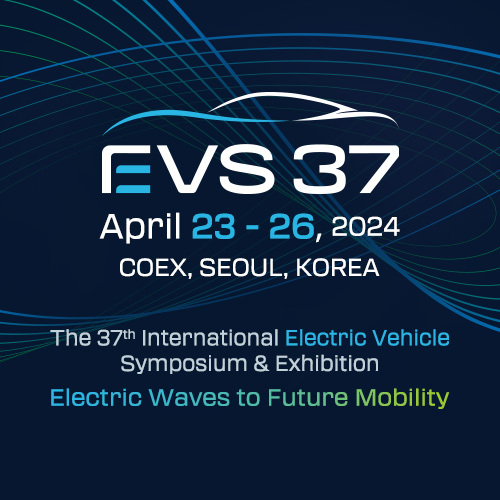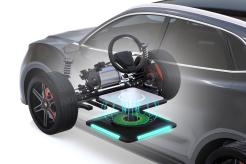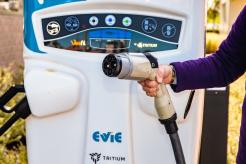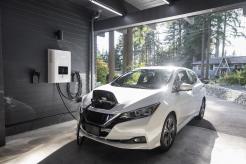Although most EV charging takes place overnight in a residential location, EV owners who live in multi-unit dwellings (MUDs) face unique barriers. Most depend on property owner/manager support to install EV charging stations.
With over 80 million Americans now living in MUDs and estimates that EVs will comprise 28 percent of all U.S. vehicle sales by 2030, demand for on-site charging stations at MUDs is growing rapidly.
Check out five case studies of MUDs that have successfully installed EV charging stations over the past four years to meet existing demand and attract new residents.
1. Clarksburg Condominiums II, Clarksburg, Maryland
In the spring of 2022, the homeowners association (HOA) for the 80-unit Clarksburg Condominiums II decided to install Level 2 EV chargers in their shared parking lot.
With so many auto manufacturers committing to phasing out ICE (internal combustion engine) vehicles within the next decade, the HOA president felt that a shared EV charging station would soon become necessary for multi-family properties like theirs. The condo management company became more enthusiastic once two-thirds of all residents agreed to the project after considering these points:
- EVs are less expensive to operate than gasoline-powered vehicles
- Installing charging infrastructure now would make EV ownership more accessible in the future
- Installing charging infrastructure would increase property values and the community’s overall appeal

(Image Source: ClarksburgCondo2.com)
To help pay for the project, the HOA took advantage of two incentives:
- The Maryland Energy Administration’s cash rebate of 40% of equipment and installation costs, up to $4,000 per station.
- Potomac Edison’s incentive of 50% of equipment and installation costs, up to $20,000 per site.
Due to the state incentive counting a dual-plug charging station as only one station, the HOA found they could install six single-port chargers for a lower net cost than three dual-port chargers. Due to those savings, they also decided to pre-wire for 11 additional chargers.
Total equipment and installation costs totaled $60,000, which had to be paid upfront before receiving the incentives funding. The HOA got financing for the entire $60,000 from a small business energy savings program.
Between the two incentive programs, Clarksburg Condominiums II HOA qualified for $44,000 in funding, for a net cost to residents of just $16,000. Maintenance service costs $10 per month per plug, and ongoing wire networking fees are about $720 annually.
Condo residents pay $0.20 per kWh to charge their EVs. With six individual chargers available, the HOA decided to offset operating costs and create a revenue stream by listing the charging station on Plugshare.com for access by the public. The public pays $0.30 per kWh.
The chargers went online in March 2022. In the first month, they powered approximately 4,000 miles of driving, offsetting 130 gallons of gasoline consumption.
2. Sage Condominiums, Scottsdale, Arizona

(Image Source: SageCondoHOA.com)
The Sage Condominiums multi-family residential community includes 122 luxury waterfront townhomes and condos in Scottsdale, Arizona, all built within the past 15 years.
When the Salt River Project (SRP) began offering incentives in 2020 for homebuilders, businesses, and residents to install charging stations, the Sage River Homeowners Association (HOA) jumped at the chance. Residents unanimously chose to install dedicated EV charging stations for every unit in the community.
Soon after the decision, the HOA realized that the community parking garage had limited electrical capacity and feared they would have to shelve the project. By choosing charging station equipment with load-balancing features, they determined they could proceed within budget and still meet the SRP incentive requirements. Ultimately, they selected Enel X JuiceBox Pro EV charging stations.
The SRP charger incentive required that property owners pay only 8% of the total charging equipment installation cost. However, as a nonprofit, the Sage Condominiums HOA qualified for a higher incentive level, receiving $5,500 per charger installed at the development’s older homes and $4,000 each for newer residences.
According to John Cordes, business development manager for the HOA: “Less than 5% of residents have EVs today. But if you build it, they will come. As a result of this project and the Enel X solution, most tenants are planning to buy EVs.”
(Image source: ChargedEVS.com)
3. Muir Commons, Davis, California
Muir Commons took advantage of a grant program from Pacific Gas and Electric (PG&E) to install 26 charging stations, one for each residential unit. Constructed in 1991, Muir Commons features private homes clustered around shared spaces, a layout known as a “co-housing community.” They were the first newly built U.S. community modeled after Denmark cohousing communities.
Muir Commons residents chose an option under which PG&E would buy and install EvBox charging hardware, pay most of the installation costs, and own and maintain the chargers for the first ten years. At that point, maintenance and ownership would pass to the residents.
The installation had its snags. The complex’s transformer was already operating at 100% capacity, so they had to install a new one. Electrical conduits had to be laid beneath the parking lot, requiring major trenching work, among other projects.
Although PG&E covered most of the estimated $20,000 per charger total installation cost, PG&E asked each household to pay $1,150 (equivalent to installing a charger in a single-family home). However, households without EVs objected. PG&E lowered the charge to $550 per household, payable at $25/month interest-free, with an additional $800 grant available to residents who bought an EV in the future.
Muir Commons is the first multi-unit dwelling electric vehicle charging project in the Davis area and was, for a time in 2019, the largest MUD EV charging project in California. County supervisor Don Saylor has been quoted as saying Muir Commons is a prime example of “how to do chargers at multi-unit dwellings (MUDs).”

(Image Source: Plugshare.com)
4. Green Rock Apartments, Minneapolis, Minnesota
Marketed as “eco-conscious urban living,” Green Rock Apartments has amenities including energy-efficient lighting, free low-watt light bulbs for tenants, solar panels, on-site composting and recycling services, community gardens, and bike parking.
Always on the lookout for ways to reduce emissions and appeal to new residents, Green Rock property owner Dale Howey took advantage of a Nissan incentive program to add a DC fast charger as its first on-site station. Nissan paid for the equipment, and the complex hired a certified electrician for installation. (Listed on the Greenlots network, this charger is also open to the public for a fee.)
After that, Green Rock installed Level 2 charging at three additional buildings and their corporate offices. The complex paid about $600 per unit to purchase Level 2 charging units (up to 4 per building) and an additional $400 per unit for installation. Although intended for tenant use, the chargers are available to the public in an emergency.
Together, the four buildings contain 97 housing units. EV owners get free parking, and the cost of charging at the Level 2 chargers is included in the rent at no additional cost. All tenants are also eligible for a $2,000 credit towards the purchase of a plug-in EV.
In addition to tenants, the complex maintenance crew uses all-electric Nissan EVs and a Polaris Ranger EV tractor for winter snow removal and summer landscaping.
“The chargers are a major draw for tenants and make the units more valuable,” Howey said. “We have seen a small bump in electricity cost. At the end of the day, though, we’re just trying to do the right thing, and tenants stick around because of the perks.”
5. 937 Condominiums, Portland, Oregon

(Image Source: Condo.com)
A LEED-certified high-rise built in the Pearl district of downtown Portland, 937 Condominiums has 16 stories, 114 condominiums, and 135 underground parking spaces.
EV charging was not a huge consideration when the 937 Condominiums were built in 2008. Initially, building owners installed six Level 1 chargers in individually deeded locations. However, the HOA faced resident demand for Level 2 EV charging stations to service Tesla vehicles.
Working with their resident electrician to install, the community now has ten individual Level 2 charging stations with Enel X WayJuiceBox equipment installed. Residents are not billed for energy usage associated with the chargers. The system extensively uses wi-fi and smart EV charging capabilities, specifically load balancing, and their electrical setup will allow up to 40 stations without upgrading electrical service.
In 2016, Portland was named the most EV-friendly city in the U.S. by the Indiana University School of Public and Environmental Affairs. As of January 2023, the Portland City Council is considering an amendment to the city zoning code that would require newly constructed MUD and mixed-use developments to install EV-ready infrastructure in at least 50% of available parking spaces.
Conclusion
As these case studies illustrate, installing EV charging stations gives MUD property owners a unique way to help attract and retain residents and foster an environmentally sustainable community.
Multifamily housing owners face unique considerations when installing charging stations, ranging from parking and electrical service access to billing and legal concerns. The Alternative Fuels Data Center of the U.S. Department of Energy provides links to resources for MUD owners, property managers, HOAs, and residents on their website.
(Featured image by JUICE on Unsplash.com)
Are you interested in learning more about EV charging and infrastructure? Join us at the upcoming EV Charging Summit & Expo!






